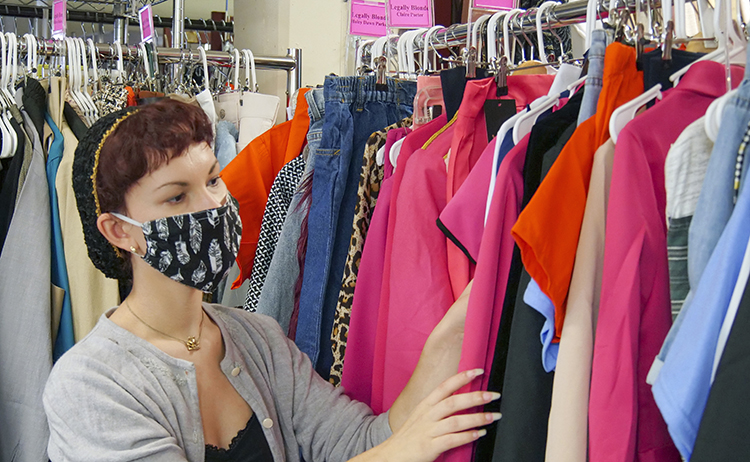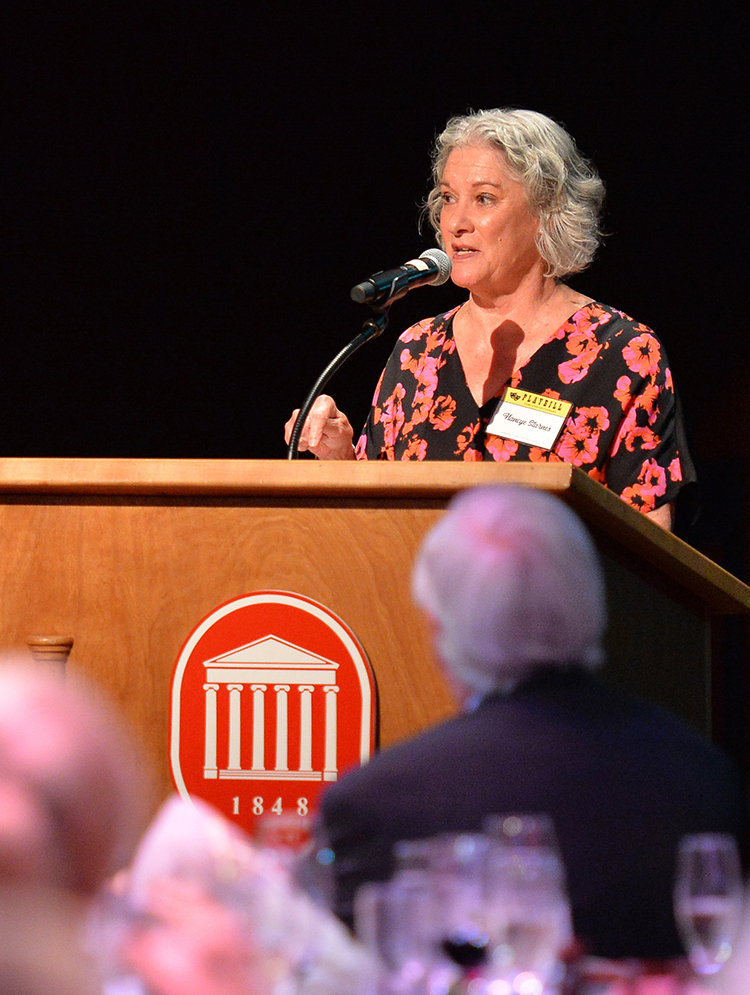
Aryana Gaines, a senior from Thompson's Station, Tennessee, who is pursuing a major in design and theater production, examines the costumes she worked to design for the upcoming Theatre and Film at UM production of 'Legally Blonde.' Photo by Mary Stanton Knight/UM Development
In the hands of a costume designer, reams of fabric can be used to transport a theater patron to another time or even another world.
A $650,000 gift establishing the Nancye Starnes Theatre and Film Fund at the University of Mississippi celebrates those transformations and expands the educational experiences of students who work to dress the stage.
“The people who create costumes put audiences in the middle of what the theater is trying to project, and those costumers play such an immense role,” said Nancye Starnes, of Daniel Island, South Carolina. “They set the tone and deserve to have the best possible environment in which to work and a space that is functional.”
Starnes witnessed the impact a live theater performance can have during “The Phantom of the Opera,”which she attended with her then 11-year-old daughter.

“She knew the music from listening to the soundtrack, and that moment for her was almost overwhelming,” said the Ole Miss alumna. “She was so excited to be in the audience and see the performers on stage.
“My daughter grabbed my hand and looked over at me with tears in her wide eyes. That’s what theater can do for a person, especially when there’s so much attention to detail.”
Starnes’ gift will support renovating and moving the costume and craft shops from Fulton Chapel to the South Oxford Campus as well as locating all the costuming classes there. The new space will be dedicated to both costume production and costume design students, and it will expand the space for the program’s production and storage needs.
“This is absolutely a transformative gift,” said Carey Hanson, professor of costume design and head of the design and theater production program. “Not only will this gift bring such an improvement to all the teaching spaces as well as the production space, but it will also allow for growth and expansion in what we can offer students educationally.
“In addition, these new spaces will allow us to bring a higher level of professionalism to the experiences the students will have in classes and while working on productions.”
The Department of Theatre and Film offers costume design and costume technology courses that prepare students for professional job opportunities. Classes are focused on the details that set the stage for audience members, such as garment patterning and draping, period patterning, tailoring, millinery, costume crafts and wig construction.
“As a transfer student, I came here looking for better opportunities in costuming,” said Aryana Gaines, a senior from Thompson’s Station, Tennessee, pursuing a major in design and theater production. “I am so thankful to have found a department that is so invested in my success, and gifts from generous donors such as Ms. Starnes create so many opportunities for students that may not be available otherwise.
“The behind-the-scenes areas of the arts can often be overlooked because the technicians and designers are not the ones seen on stage. Creating art is a team effort and putting on a show takes a village and each part is equally important.”
Gaines’ designs will be seen in the Theatre and Film at UM fall semester production of “Legally Blonde.”
“We appreciate gifts like these for spaces, supplies and opportunities to improve the learning experience in this very hands-on field of study,” she said.
John Polles, an alumnus of the theater and film program who served as an assistant costume designer with The Juilliard School and worked with the Santa Fe Opera, agreed that support will ensure students have exceptional opportunities as they prepare for their careers.
“This gift is really going to help foster a work environment that is on par with the high level of classes being taught at the university,” Polles said. “This gift being specifically for the costume department is validating. Many times, we do what seems to be a thankless job.”
For Starnes, the originality of the Ole Miss costume and design students is to be celebrated.
“The students are wonderfully creative,” Starnes said. “I am delighted to contribute and am looking forward to seeing the environment they create.”
By Mary Stanton Knight



